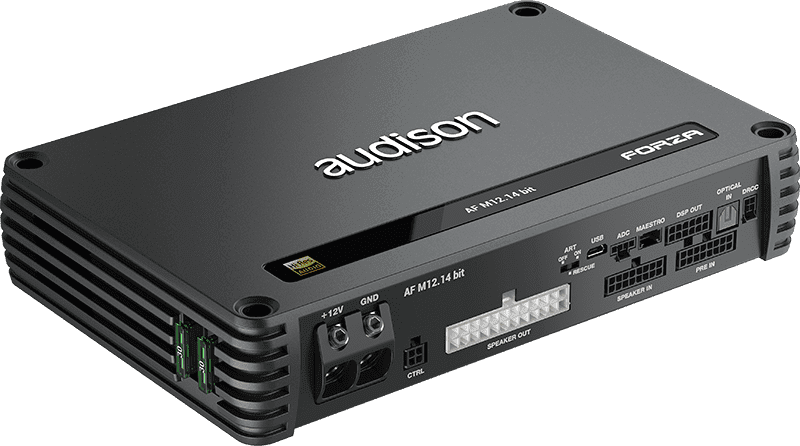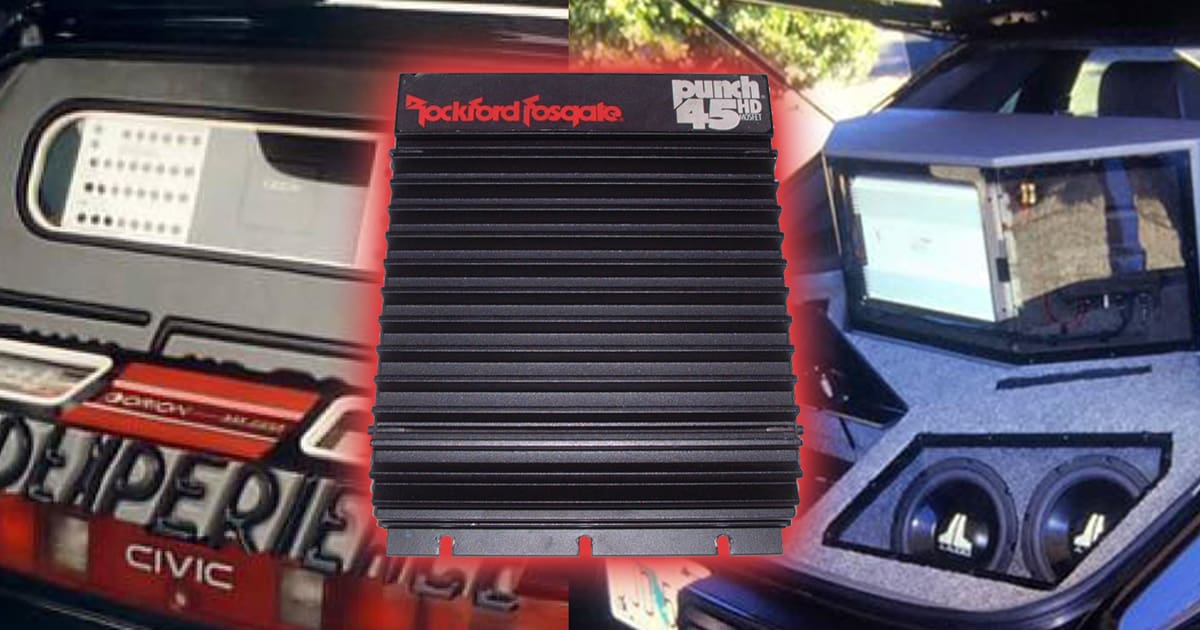In the late 80s and early 90s, a car audio fad involved running an entire multi-speaker system with subwoofers from a single two-channel car audio amplifier. Why were people building these systems? The primary driving factor was a 0 to 50-watt class in car audio sound-offs. In other cases, it was to show off the capabilities of an amplifier in a demo vehicle. These days, audio amplifiers with a dozen channels are readily available. Back then, even a four-channel amp was somewhat rare. Let’s take a look at how these systems were designed and integrated into a vehicle.
Modern Audio System Design
With the prevalence of digital signal processors and inexpensive multi-channel amplifiers, designing a fully active car audio system is commonplace. An active system refers to each speaker in the vehicle being driven by a dedicated amplifier channel. More specifically, no passive electronic components like capacitors and inductors are used between the amplifier and the speaker to filter the audio signal. All the filtering and equalization are done before the audio signal reaches the amplifier.
Active system designs offer several huge configuration and calibration benefits. First and foremost, the level of each speaker in the vehicle is nearly infinitely adjustable. Do you need that tweeter two feet away to play at the same volume as the one on the other side of the car? Any good DSP can do that.
Next, through that same processor, your installer has nearly unlimited control over crossover frequencies and slopes. They can protect each speaker from damage due to excursion or power issues. Further, each speaker will play right up to the crossover point of the next driver with minimal concern about overlap.
A half-dozen other benefits include signal delays, phase filters, signal processing features built into the DSP chip, and system presets. It just makes sense to design a system this way.

Passive Car Audio Systems
You can think of a passive car audio system like a home tower speaker works. You might have a woofer, midrange, and tweeter, all fed from a single pair of speaker wires that connect to your amplifier. These are called passive because no power supply is required for the capacitors, inductors, and resistors inside the speaker cabinet. Put another way, these are all passive components, as compared to active ones you’d find in a DSP or an electronic crossover.
The first problem with passive components is their accuracy. Resistors, capacitors, and inductors might have a five to ten percent tolerance. If you have designed a passive high-pass filter, the exact crossover frequency might not be what you thought it was. If the high-pass crossover ends up being a little higher than you wanted and the low-pass network’s -3dB frequency is a little lower, you end up with a dip in the frequency response.

Pasive Crossovers are Difficult to Design Accurately
Further, most passive crossover designer software makes assumptions about a speaker’s impedance. Assuming a nominally four-ohm speaker measures four ohms will result in issues. The better systems can accept realistic models of a speaker to improve the network’s performance.
Additionally, speakers aren’t resistors—they are reactive components. Their impedance changes as frequency changes. It also changes based on cone position. Hoping you can get a set of passive crossover components to hit a specific frequency is very difficult. Most high-quality passive networks are simulated in software and then tested in anechoic chambers or vehicles. The measurements typically result in changes to component values, which costs a lot of money. This isn’t an issue if you are designing a set of $10,000 home speakers. If you are trying to make a pair of midrange speakers and tweeters in your car sound good, you will spend hundreds of dollars on crossover parts and dozens of hours fine-tuning the results.


Modern Car Audio Systems
In a modern car audio system, we typically have four or five channels of amplification. You might have left and right channels for the front speakers, another set of left and right channels for the rear speakers, and a channel for the subwoofer. You can forego the rear speakers and create an amazing audio system from a three-channel amp.
There’s a bit of a catch here. A modern system might combine some active filtering between the subwoofer and high-frequency amplifier and passive components between the midrange speakers and the tweeters. Most car audio systems with two amplifiers are a hybrid of active and passive filtering.

If you have the crossovers available, you could use two channels of a four-channel amp to power the midrange speakers and the other two to power the tweeters. Combine that with a mono amp for the subs, and now you have a fully active system.

Single-Amp Car Audio Systems
Imagine a car audio system with four 10-inch subwoofers to handle bass frequencies. Combine that with 6.5-inch woofers, four-inch midrange drivers, and tweeters. Now, imagine that each door of a four-door sedan had one speaker of each size. That’s 12 speakers and four subwoofers. Take that a step further and imagine all of it powered by a single two-channel amplifier. How? Passive crossovers. Lots of passive crossovers.
Single-Amp Car Audio System Design
The trick to making one of these systems sound acceptable was to have enough subwoofer cone area so that the bass would be loud relative to the mids and highs. A pair of 12-inch drivers was often enough, especially if the amp would play into a low load impedance. The system design above shows four 10-inch drivers for bass. Rockford Fosgate Punch and Orion HCCA amplifiers didn’t mind having the subwoofers wired to present a one-ohm load. Further, the subwoofers would be wired in a BTL or bridged configuration. The amp would “see” a half-ohm per channel.
As we know, loading amps down is a terrible idea in terms of sound quality. First, they become incredibly inefficient. Further, amplifiers add more distortion to an audio signal when running low-impedance loads. However, you do what you must do when you don’t have a way to increase the subwoofer output relative to the mids and highs.
Passive Crossover Considerations
Next, we must look at the passive crossovers for the high-frequency drivers. If the system is simple, you need a high-pass crossover for the woofers and a low-pass crossover where the tweeters start playing. Finally, we need crossovers for those tweeters. Assuming simple second-order filters, that’s a pair of capacitors and inductors on each woofer and another cap and inductor on the tweeter. If the tweeter is too loud, which it likely will be, you’ll need resistors to pad the tweeter output. Now, multiply that by two, as you need the same for the other side of the car.
Rockford Fosgate used to suggest using four-ohm speakers in the front doors and eight-ohm speakers in the rear doors. The goal was to make the rear speakers quieter as they would draw less current from the amplifier. You need entirely different passive component values for nominally eight-ohm speakers than for four-ohm drivers. Add another stack of parts to that shopping list.
Image: 8 MB Quart MUSiCOMP Crossovers.jpg
Image Caption: Premium crossover networks like these MUSiCOMP units from MB Quart were popular through the 80s and 90s.


The Competition Classics
People who understand how car audio systems work would never build one with passive crossovers these days. The cost and challenge of getting all the parts right simply isn’t worth the hassle. Nevertheless, that didn’t stop people from doing it decades ago. Here are some blasts from the past that some of us that have been around the block for a while will remember.
First, we have Lucio Proni and his Ford Mustang GT. This system used a two-channel Precision Power Inc. amp to drive an amazing 25 speakers. James Birch and Lucio are the J and L in JL Audio. Thanks to Manville Smith for sharing the images.


Second is Dan Polhamus’ Honda Civic. Dan’s Civic featured an Orion 250 HCCA amplifier, Orion XTR subwoofers, Orion midbass speakers, AudioControl equalizers, two MB Quart speakers systems in each door and Pioneer electronics. He won several major car audio events throughout his Autosound career.


Second is Dan Polhamus’ Honda Civic. Dan’s Civic featured an Orion 250 HCCA amplifier, Orion XTR subwoofers, Orion midbass speakers, AudioControl equalizers, two MB Quart speaker systems in each door, and Pioneer electronics. He won several major car audio events throughout his Autosound career.
Classic One-Amp Car Audio Systems
Well, there’s this month’s trip down memory lane. Whether they were competing for a trophy or trying to show off how a small, low-power amp could drive a few dozen speakers, single-amp car audio systems were definitely a thing a few decades ago.

